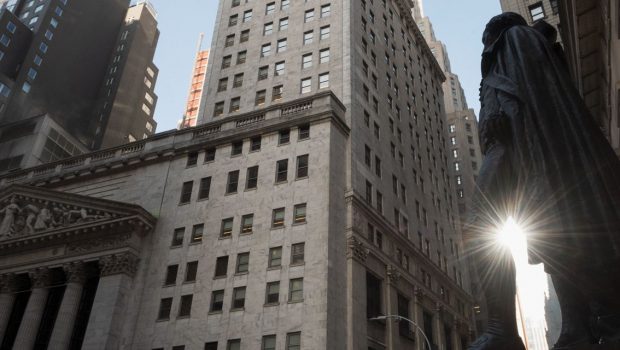Why Are Tech Stocks Down? It’s Not Just the Fed.
Tech investors may already be questioning their hopes for 2022. A 3.3% slide for the technology-heavy
Nasdaq Composite
index Wednesday—part of a broader market rout—capped off a very ugly start to the year.
In fact, the Nasdaq has suffered its worst three-day start to a year since 2008, and has lost in the range of $1 trillion this week alone.
Some of the most popular tech names have been among the casualties:
Tesla
(ticker: TSLA) has tumbled more than 9% since the start of 2022, while
Apple
(AAPL) has fallen 3.9%.
Alphabet
(GOOGL) is down 5% and
Nvidia
(NVDA) has slumped 8.4%.
The picture was somewhat less gloomy Thursday. Stocks broadly were mostly rebounding, though the
Nasdaq-100
—tracking the largest constituents in the index—was still on track to open down 0.4%.
Why have tech stocks fallen? Many on Wall Street blame the Federal Reserve and bond yields.
Minutes of the December meeting of the Federal Open Market Committee released Wednesday suggest the Fed is headed for earlier, faster rate hikes, and more aggressive policy tightening. As part of that, the central bank is set to normalize—read: shrink—its balance sheet, which has ballooned to nearly $9 trillion amid the Fed’s pandemic-era program of quantitative easing, which adds liquidity to markets.
“We, and the market, found the tone to be more hawkish than anticipated,” said Mark Haefele, the chief investment officer at UBS Global Wealth Management. “The rate rise had begun to weigh on growth and technology stocks.”
Indications of the Fed’s next moves, as well as its view of a strong U.S. economy, were good for bond yields. Following the release of the Fed minutes, the yield on the benchmark 10-year U.S. note spiked. It was even higher Thursday at nearly 1.75%, having started the week at just 1.53%.
Interest rate hikes, less liquidity in markets, and higher bond yields are all bad news for tech stocks. Elevated yields, in particular, tend to discount the present value of future cash flows—and the valuations of many tech stocks are reliant on the notion of profits well into the future.
“As tech has been the largest winner of the Covid-era, it seems reasonable for there to be a rotation …toward other sectors that have lagged as the Fed’s minutes allude to a healthy economy that may warrant a faster normalization of Fed policy,” said Kevin Philip, a managing director at Bel Air Investment Advisors.
Philip views high-valuation tech stocks—like the constituents of Cathie Wood’s ARK exchange-traded funds—as being particularly vulnerable to a normalizing environment.
Jeffrey Halley, an analyst at broker Oanda, was less delicate. He categorizes this week’s tech selloff as “a massive rush for the exit in the most [quantitative easing]-driven pimp-up-my-asset classes.”
But Halley sees the volatility in the market as being more about positioning than anything else, “because when you look at what the Fed members said in the FOMC Minutes, it wasn’t really anything different than what we already knew.”
Others have echoed this sentiment: What we’ve seen is big money jockeying for position in a changing market. This could, in part, be due to overcrowding. In short: Everyone owns the same stocks.
That’s the view espoused by Matt King, a strategist at Citi, who sees the gradual slowing of stimulus by central banks as having contributed to the conditions for the recent selloff.
“As the flow of new money creation has dwindled, so the rally has become dangerously narrow,” King said. “For a healthy investment outlook, it’s best not to linger too long in crowded spaces.”
The data bears this out. Institutional investors were most overweight in some key tech stocks as of the end of last week, according to research from Swiss bank UBS released Tuesday.
Microsoft
(MSFT) was the most overweight stock among global active fund managers as of the end of last week, followed by
Meta Platforms
(FB). Two classes of Alphabet stock (GOOGL and GOOG) held the fifth and sixth positions, respectively, with
Netflix
(NFLX) rounding out the top ten.
All this begs the question: What should tech investors do next?
For Bel Air’s Philip, it’s a matter of wait and see. “I suspect we will see a limited period of time where tech takes a breath, before it continues being a stable source of economic and market strength. I would be a buyer on weakness,” he said.
As for Oanda’s Halley, he’s watching Friday’s U.S. jobs report and non-farm payrolls as a possible catalyst for sentiment. “I wouldn’t write off the irresistible power of the buy-the-dippers turning things around once again before the end of the week, especially if the U.S. Non-Farm Payrolls comes in under 400k,” he said.
The most bullish of the tech bulls remain bullish.
“Is this the end of the tech party or is it a major buying opportunity during a white knuckle sell off?” asked Dan Ives, an analyst at broker and investment bank Wedbush. “Our answer emphatically is that many of the secular tech winners we believe will drive the 4th Industrial Revolution are now in oversold territory.”
But in a year that many believe will be more volatile than 2021, tech investors should remain vigilant. The end to abnormal, pandemic-era monetary policy conditions could make price swings more dramatic, and more two-way.
“The ‘buy everything’ trade powered by ‘buy the dip; any dip’ is on its last legs,” said Halley. “Those most pimped-up asset classes valuation-wise are the most vulnerable to meaningful downside corrections.”
Write to Jack Denton at jack.denton@dowjones.com








Gloss